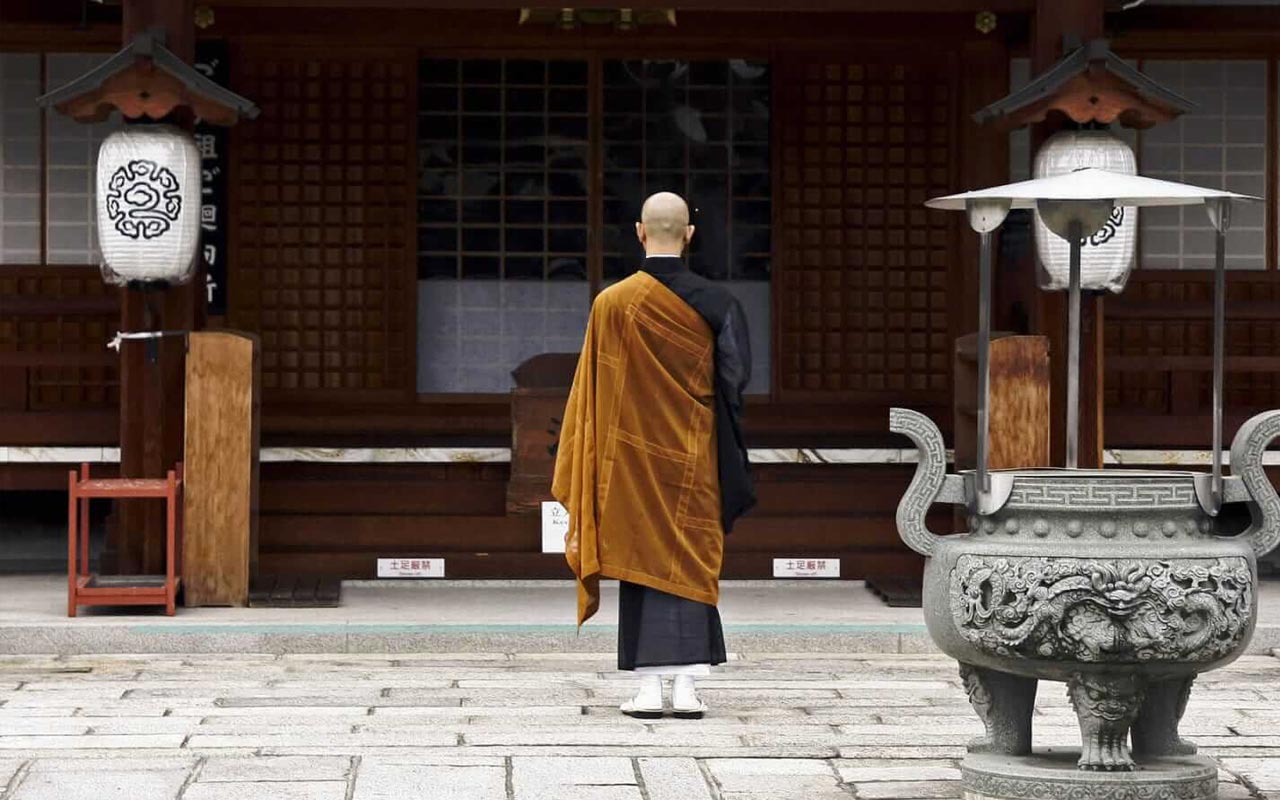What is “Nanso Meditation”?
As someone coming from a Soto Zen background, my recent discovery of this traditional Rinzai meditation practice called “Nanso Meditation” has been an interesting discovery!
Rinzai Zen, known for its emphasis on koan practice and rigorous training, incorporates a unique meditation method that resembles the mind-body practices found in Chinese Daoist traditions. The practice of Nanso no Ho, also known as Nanso Meditation, integrates visualization and the activation of vital energy (ki) to promote self-healing and spiritual cultivation.
In this article, we will explore this fascinating Nanso Meditation, delving into its origins, techniques, and the profound impact it can have on our overall well-being and health.
What is Nanso Meditation (Nanso no Ho)?
Nanso Meditation, aka Nanso no Ho, or “soft-ointment meditation,” is deeply rooted in the teachings of the influential Zen master Hakuin Ekaku (1686-1769). Hakuin is a central figure in the Rinzai school of Zen Buddhism, and his teachings have significantly impacted the development and spread of Zen practices.
Hakuin Ekaku was known for his rigorous meditation approach and emphasis on koan practice. However, his intense dedication to these practices led to several bouts of what he described as “Zen sickness” – a state of physical and mental exhaustion. While searching for a cure for this ailment, he encountered a hermit named Hakuyu, who taught him how to visualize energy descending from the head and permeating the body. This practice would later become known as Nanso Meditation.
Hakuin found that this practice alleviated his Zen sickness and deepened his meditative practice. He began teaching this method to his students to balance intense meditation with a practice that restored, revitalized, and healing the body and mind through visualization.
How is Nanso Meditation Practiced?
Nanso no Ho is an effective, transformative practice within the Rinzai school of Zen Buddhism. It is not merely a relaxation or stress relief method but a profound visualization exercise that promotes self-awareness, healing, and spiritual growth.
Nanso no Ho Meditation is a unique form of meditation that combines visualization and mindfulness. It’s an experience of self-discovery and transformation that requires patience, focus, and a willingness to engage deeply with one’s desire to heal. Here are the steps to practice this transformative meditation:
- Find a Quiet Space: Find a quiet and comfortable space where you won’t be disturbed. This space should promote a sense of peace and tranquility, helping you focus on the meditation.
- Assume a Comfortable Position: Sit on a cushion on the floor in a traditional meditation posture, or a chair can be used if uncomfortable. The key is maintaining an upright and relaxed posture, allowing free breath and energy flow.
- Begin the Visualization: Close your eyes and imagine a fragrant ball of soft, warm butter, the size of an egg, placed on the top of your head.
- Visualize the Melting Butter: As you focus on this image, visualize the warm butter slowly melting. As it melts, it imparts an exquisite sensation, moistening and saturating your head within and without.
- Follow the Flow: Continue the visualization, imagining the melted, comforting butter flowing down, moistening your shoulders, elbows, and chest, permeating lungs, diaphragm, liver, stomach, kidneys, and bowels, moving down the spine through the hips, pelvis, and buttocks.
- Continue the Visualization: As his vital energy flows downward, it gradually fills the lower region of the body, imbuing it with penetrating warmth, making him feel as if he were sitting up to his navel in a hot bath filled with a decoction of rare and fragrant medicinal herbs that have been gathered and infused by a skilled physician.
- Maintain the Practice: Continue to practice the contemplation with diligence. Whether such results appear swiftly or slowly depends only on how carefully you apply yourself.
What are the Benefits of Nanso no Ho Meditation?
The transformative potential of Nanso Meditation extends beyond spiritual growth, offering a range of physical, mental, and emotional benefits. This section will delve into these benefits, shedding light on why this practice is a valuable addition to a holistic wellness routine.
Physical Benefits
Nanso meditation is a practice that encourages deep relaxation through the visualization of healing energy permeating the body. This state of relaxation can have a positive impact on various physical aspects:
- Stress Reduction: Regular practice can help lower stress levels, improving overall health and well-being.
- Blood Pressure: The deep relaxation achieved through Nanso no Ho can help lower blood pressure.
- Improved Sleep: Nanso no Ho can improve sleep quality by promoting relaxation and reducing stress.
- Enhanced Vitality: Visualizing healing energy flowing through the body can foster a sense of physical well-being and vitality.
Mental and Emotional Benefits
On the mental and emotional front, Nanso no Ho Meditation can serve as a powerful tool for cultivating inner peace and emotional balance:
- Anxiety Reduction: The practice encourages mindfulness and present-moment awareness, which can help alleviate anxiety.
- Mental Clarity: Regular practice can improve mental clarity, aiding focus and decision-making.
- Emotional Resilience: The process of visualizing healing energy can foster a positive mindset and help cultivate emotional resilience.
Spiritual Benefits
From a spiritual perspective, Nanso no Ho Meditation is a cornerstone of the Rinzai school of Zen Buddhism, offering a pathway to self-realization and enlightenment:
- Self-Realization: By focusing on the flow of vital energy within the body, practitioners can cultivate a deeper connection with their inner selves.
- Interconnectedness: The practice can lead to a deep sense of interconnectedness with all of life, fostering a sense of unity and compassion.
- Spiritual Insights: Regular practice can lead to profound spiritual insights, enhancing personal growth and understanding.
The benefits of Nanso no Ho Meditation are multifaceted, encompassing physical, mental, emotional, and spiritual well-being. This practice, rooted in the teachings of Zen master Hakuin Ekaku, offers a holistic approach to wellness, promoting not just physical health but also mental clarity, emotional resilience, and spiritual growth.
What Makes Nanso Meditation Work?
At the core of Nanso no Ho Meditation’s effectiveness lies the power of imagination and the activation of ki circulation. Nanso no Ho harnesses the transformative potential of visualization, tapping into the profound connection between the mind and body.
Through visualizing a lump of melting butter permeating the body, practitioners activate the imagination to create a healing environment within. This visualization serves as a catalyst for directing the flow of ki, the life force energy, throughout the body.
Drawing inspiration from traditional Chinese medicine, where ki plays a vital role, Nanso Meditation utilizes the power of imagination to stimulate ki circulation, promoting balance, harmony, and self-healing. By engaging the mind’s creative capacities, Nanso no Ho invites practitioners to embark on a transformative journey, where the subtle energy of imagination merges with the body’s innate healing wisdom, fostering a deep sense of well-being and revitalization.
How Does Nanso no Ho Meditation Compare to Other Forms of Meditation?
Understanding the distinctions between Nanso Meditation and other forms of meditation is essential in recognizing this practice’s unique focus and benefits, primarily focusing on healing. This section will explore the differences between Nanso no Ho and three popular forms of meditation: Mindfulness Meditation, Transcendental Meditation, and Loving-Kindness Meditation, highlighting the distinct healing aspect of Nanso no Ho.
Nanso Meditation vs. Mindfulness Meditation
While both Nanso no Ho Meditation and Mindfulness Meditation share a focus on present-moment awareness and relaxation, Nanso no Ho places a specific emphasis on healing. It incorporates a visualization technique where practitioners imagine healing energy permeating their body, promoting self-healing and restoration. In contrast, Mindfulness Meditation focuses more broadly on non-judgmental observation of thoughts and sensations to reduce stress and improve overall well-being.
Nanso Meditation vs. Transcendental Meditation
Nanso no Ho Meditation and Transcendental Meditation differ in their origins and approaches. Transcendental Meditation aims to achieve a state of transcending thought using personalized mantras. While Transcendental Meditation offers various benefits such as relaxation and stress reduction, Nanso no Ho Meditation stands out for its primary emphasis on healing. The visualization of healing energy within the body in Nanso no Ho cultivates a deep sense of self-healing and rejuvenation.
Nanso Meditation vs. Loving-Kindness Meditation
Nanso Meditation and Loving-Kindness Meditation focus on different aspects of inner development. Loving-Kindness Meditation, also known as Metta Meditation, aims to cultivate feelings of compassion, love, and well-wishing towards oneself and others. On the other hand, Nanso no Ho Meditation primarily centers around healing. By visualizing healing energy flowing through the body, practitioners facilitate physical and spiritual healing, promoting inner peace and well-being.
By comparing Nanso no Ho Meditation to other forms of meditation, it becomes clear that its unique focus on healing sets it apart. The practice offers a powerful tool for self-restoration, nurturing the body, mind, and spirit toward greater harmony and well-being.
Conclusion
As someone deeply interested in Daoist health practices and a Zen practitionner, I was really glad to have discovered Nanso Meditation as it presents a unique pathway to self-healing and wellness. This practice promotes balance, harmony, and inner peace by harnessing the power of visualization and activating the body’s ki circulation and helping heal ailments.
Regardless of your meditation experience, incorporating Nanso no Ho into your daily routine is accessible and very beneficial. Let’s embrace the transformative benefits of Nanso no Ho Meditation by visualizing healing energy flowing through your body and experiencing the profound effects on our well-being.

